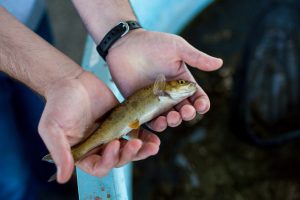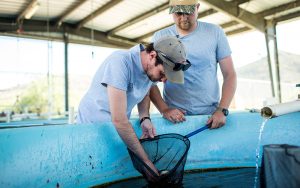- Slug: BC-CNS-Roundtail Chub. 485 words.
- Photos and captions below.
- Video here.
By BRYCE NEWBERRY
Cronkite News
PHOENIX – There’s a fundamental question over the roundtail chub, a minnow native to Arizona: Is it endangered or not?
The Center for Biological Diversity in Tucson in August sued the U.S. Fish and Wildlife Service for not protecting it. But the Arizona Game & Fish Department, which works with federal agencies to protect existing native fish, says there’s no reason to worry – the species is doing just fine.
Brian Segee, senior attorney for the Center for Biological Diversity, contends the situation is dire.
“The roundtail chub, whether it subsumes the other species of chub, the headwater chub and the Gila chub, is highly imperiled,” he said.
Segee points to threats, including non-native fish, climate change, dam construction and human development along streams, as reasons why the roundtail chub – about 11 inches long, olive gray in color, with silvery sides and a white belly – should be listed as endangered.
The fish, which historically has lived in pools and streams in the Upper and Lower Colorado River basins, was a candidate for endangered-species protection in 2015. That’s when Fish and Wildlife authorities proposed listing it to help keep the fish from extinction.
But two years later, the agency revealed new scientific information that indicated the roundtail chub and two other chub species actually are identical. Suddenly, the chub population increased enough that the roundtail chub doesn’t needs protection.
“It’s really hard to distinguish the species; they look very similar,” said Julie Carter, manager for the Arizona Game & Fish Department’s native aquatics program. “It became increasingly complicated when we were finding new populations of chub to know which they were.”
The department’s hatchery in Cornville works to repopulate Arizona streams with roundtail chub.
“We let them spawn naturally every year,” said Sarah Taylor, manager of the Bubbling Ponds Fish Hatchery, operated by Arizona Game & Fish. “We take out the young of the year in the wintertime once they’re big enough to handle a pond harvest. … And we take those fish out and stock them into Verde River, into either the main channel or into tributaries of the Verde River.”
Depending on the year, hundreds or up to tens of thousands of roundtail chub are released into waterways. But the Center for Biological Diversity still wants action.
“We just want the Fish and Wildlife Service to go back and do another status review and then decide whether or not to issue a proposed rule in a timeframe that would be around a year,” Segee said.
The U.S. Department of Justice, which represents the U.S. Fish and Wildlife Service, has until Friday, Oct. 19, to respond to the suit. A spokesman for the service declined to comment, saying the agency doesn’t discuss ongoing litigation.
This story is part of Elemental: Covering Sustainability, a multimedia collaboration between Cronkite News, Arizona PBS, KJZZ, KPCC, Rocky Mountain PBS and PBS SoCal.
Follow us on Twitter.
For more stories from Cronkite News, visit cronkitenews.azpbs.org.
^_=


